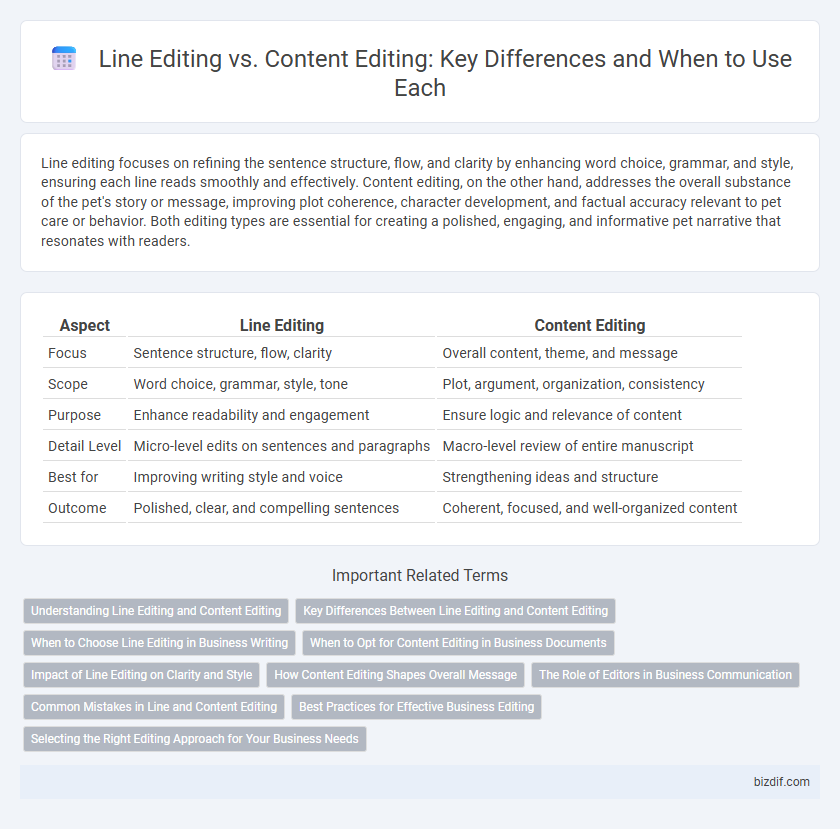Line editing focuses on refining the sentence structure, flow, and clarity by enhancing word choice, grammar, and style, ensuring each line reads smoothly and effectively. Content editing, on the other hand, addresses the overall substance of the pet's story or message, improving plot coherence, character development, and factual accuracy relevant to pet care or behavior. Both editing types are essential for creating a polished, engaging, and informative pet narrative that resonates with readers.
Table of Comparison
| Aspect | Line Editing | Content Editing |
|---|---|---|
| Focus | Sentence structure, flow, clarity | Overall content, theme, and message |
| Scope | Word choice, grammar, style, tone | Plot, argument, organization, consistency |
| Purpose | Enhance readability and engagement | Ensure logic and relevance of content |
| Detail Level | Micro-level edits on sentences and paragraphs | Macro-level review of entire manuscript |
| Best for | Improving writing style and voice | Strengthening ideas and structure |
| Outcome | Polished, clear, and compelling sentences | Coherent, focused, and well-organized content |
Understanding Line Editing and Content Editing
Line editing focuses on refining sentence structure, word choice, and flow to enhance readability and style at the paragraph and sentence level. Content editing involves evaluating the overall structure, coherence, and consistency of ideas to ensure the manuscript's message and themes are clear and engaging. Understanding the distinctions between line editing and content editing helps writers target specific aspects of their work for improvement, leading to a polished and compelling final draft.
Key Differences Between Line Editing and Content Editing
Line editing focuses on refining the style, tone, and flow of the prose by addressing sentence structure, word choice, and readability. Content editing involves broader structural changes, including plot consistency, character development, and overall narrative coherence. Key differences between line editing and content editing lie in their scope: line editing hones the language at the sentence level, while content editing evaluates and reshapes the manuscript's core elements and organization.
When to Choose Line Editing in Business Writing
Line editing is essential in business writing when the focus is on enhancing clarity, tone, and flow at the sentence and paragraph level without altering the overall structure or content. Choosing line editing is ideal for refining language, improving word choice, and ensuring consistency in style, which helps maintain professionalism and reader engagement. This type of editing is most effective after completing content editing and when the message is clear but needs polish for better readability and impact.
When to Opt for Content Editing in Business Documents
Content editing in business documents is essential when clarity, tone, and overall message alignment with company goals require improvement beyond grammar and syntax. Choose content editing to restructure ideas, enhance flow, and ensure the document effectively persuades or informs the target audience. This process is crucial for strategic communications, proposals, reports, and marketing materials where the impact of content drives business outcomes.
Impact of Line Editing on Clarity and Style
Line editing sharpens sentence structure, word choice, and flow to enhance the clarity and style of a manuscript. This detailed editing process targets grammar, syntax, and rhythm, ensuring each sentence conveys its intended meaning effectively. The impact of line editing results in a polished, engaging narrative that resonates clearly with readers and maintains a consistent authorial voice.
How Content Editing Shapes Overall Message
Content editing shapes the overall message by refining the structure, clarity, and flow of the text to ensure the intended meaning resonates with the target audience. It addresses big-picture elements such as tone, consistency, and the logical progression of ideas, which directly influence reader engagement and comprehension. Unlike line editing, which focuses on grammar and style at the sentence level, content editing transforms the core message to enhance impact and coherence.
The Role of Editors in Business Communication
Line editing sharpens sentence clarity, grammar, and flow to enhance the reader's experience, while content editing ensures the message aligns with strategic business goals and audience needs. Editors in business communication refine language precision, tone, and structure to boost professionalism and brand consistency across documents. Their expertise drives clear, impactful messaging that supports effective decision-making and stakeholder engagement.
Common Mistakes in Line and Content Editing
Common mistakes in line editing include overlooking sentence structure issues, inconsistent tone, and grammar errors that disrupt readability, while content editing errors often involve failing to address plot inconsistencies, character development gaps, and overall narrative flow problems. Editors sometimes confuse the scope of line editing with content editing, leading to missed opportunities for improvement in clarity and coherence. Distinguishing between line editing's focus on language precision and content editing's emphasis on story structure is essential for effective manuscript revision.
Best Practices for Effective Business Editing
Line editing emphasizes refining sentence structure, grammar, and word choice to enhance clarity and readability, while content editing focuses on the overall organization, coherence, and strength of ideas within the business text. Best practices for effective business editing include maintaining a consistent tone aligned with the brand voice, ensuring factual accuracy, and eliminating jargon to improve accessibility for the target audience. Employing a dual approach that integrates both line and content editing ensures polished, persuasive, and professional business communication.
Selecting the Right Editing Approach for Your Business Needs
Selecting the right editing approach for your business depends on your specific goals: line editing hones in on sentence structure, clarity, and tone to enhance readability, while content editing addresses overall organization, flow, and accuracy of ideas. For businesses aiming to refine messaging and ensure engaging, precise communication, combining content editing with line editing often yields the most professional outcomes. Tailoring your editing strategy to the content type--marketing materials, technical documents, or creative writing--ensures efficient resource use and maximizes impact.
Line Editing vs Content Editing Infographic

 bizdif.com
bizdif.com